The Razer Blade Stealth Review: Razer Takes On The Ultrabook
by Brett Howse on March 29, 2016 8:00 AM EST- Posted in
- Laptops
- Razer
- Skylake
- Razer Blade Stealth
- eGFX
- Razer Core
- Skylake-U
Display
Razer offers two displays in the Stealth. The lower priced offering is a QHD 2560x1440 panel, which is typically the higher resolution offering on most Ultrabooks. With the 12.5-inch screen, that makes for a respectable 235 pixels per inch. For most notebook tasks, this works well. The default DPI setting is a custom level slightly under 175%, which works well for the screen size. The QHD panel offers 100% sRGB gamut coverage.
However for those that want to take it to eleven, Razer will outfit the higher end models of the Stealth with a UHD 3840x2160 display. Considering the compact 12.5-inch screen, that works out to a smartphone-esque 352 pixels per inch. Razer isn’t the only company to offer UHD at this screen size, but it does put them right at the top of the heap when it comes to pixel density on a notebook. I’ll admit I was skeptical that this was necessary, because there are certainly downsides of such a high resolution as well, but seeing both units side by side, I can pretty easily see how much sharper the UHD model is even with my old eyes. The UHD display also covers 100% of the much larger Adobe RGB color space.
Here is kind of where we run into an issue though. Most notebooks that offer 100% Adobe RGB color space support also offer a way to switch the notebook from one color space to another – namely the sRGB color space – which is what is used for most of the web and many applications, while the wider gamuts are for use when needed for doing photo work in color space-aware applications. That is not the case with the Stealth though. It offers no extra functionality for this and that means it is in Adobe RGB mode all the time.
Now, it’s easy to fault Razer here, and of course they should have provided an sRGB if they were going to go down this path. Since pretty much everything is created for sRGB, viewing sRGB images on an Adobe RGB gamut display can cause duller images that you would expect, which is kind of the opposite result that you would want. The Adobe RGB color space is much more vibrant than sRGB and viewing appropriate images in Adobe RGB is very appealing. However, we are kind of at a transition point where sRGB is what most things are, but we are finally getting LED based monitors which can cover a wider gamut.
The real solution here is that Windows 10 needs to do a better job with wide gamut displays and correctly mapping a sRGB image into the wider space, but at the moment it doesn’t do that. We’ve seen a rise in standards which require a wider gamut, like DCI-P3 and the very wide Rec. 2020, but Windows’s handling of these makes it very much up to the application. Hopefully we’ll see some movement there from Microsoft.

Example of Adobe RGB Color Space
With that preamble out of the way, let’s get down to the displays themselves. Razer includes a default icc profile for their panels, which can help with the grayscale and color temperature. It’s the next best thing behind individually calibrating the panels, and because it is a generic profile it won’t mask issues with individual panels. The QHD model was tested against sRGB and the UHD model was tested against Adobe RGB. Contrast and brightness were measured with an X-Rite i1Display Pro colorimeter, and color accuracy was tested with an X-Rite i1Pro2 spectrophotometer. SpectraCal’s CalMAN 5 suite was used with a custom workflow.
Brightness and Contrast
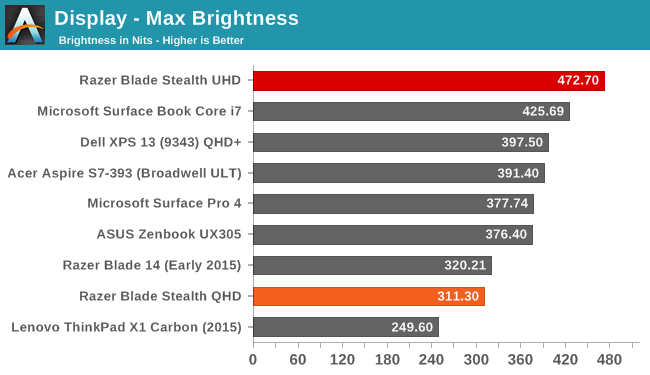
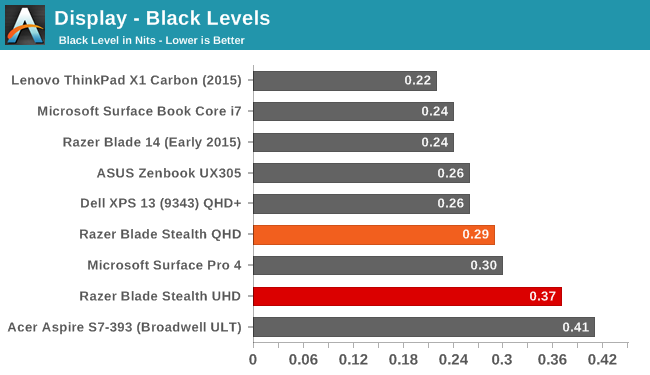
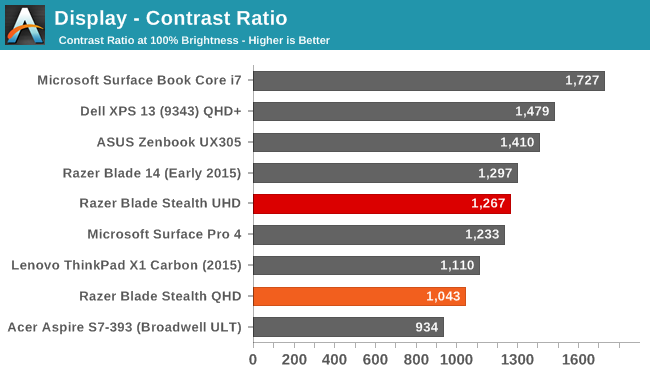
Both panels do well here, but the UHD one is amazingly bright. In fact I'd say that it's almost smartphone bright. It’s not every day a laptop that can hit almost 500 nits lands on my desk, and the excellent thing is that it hits this very high brightness level, but also keeps the black levels reasonably in check. 1200:1 contrast is not chart topping, but it’s still very good for a laptop LCD.
Grayscale and White Point


Out of the box, the Razer default ICC profile is available to help correct temperature and grayscale. On the two models I had, the grayscale was not as accurate as I’ve seen in other products from Razer, which due to them not individually calibrating each display. A generic profile can only do so much. What it did help with a lot though was the color temperature. On the QHD version, removing the ICC profile would make the display a lot cooler. Regardless there’s room for improvement here from Razer. Luckily this is the one area where a display calibration can make the most impact. The QHD model in particular had some issues very early in the range.
Saturation
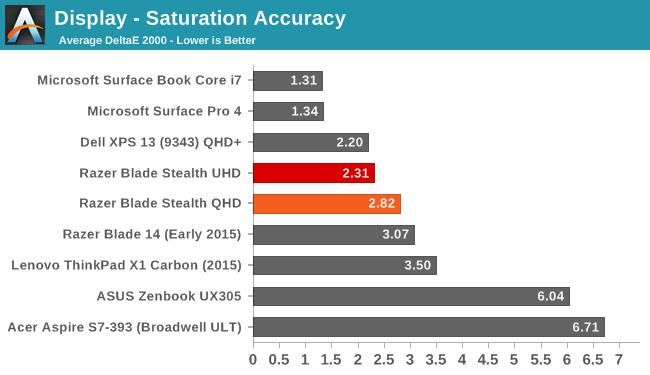
Luckily the issues with grayscale were relegated to just that. On the saturation sweeps, the display is much more accurate in the target color space. Here it is clear how much larger the color space is on the UHD model. Both displays can pretty much hit the entire gamut they are targeting, whether it be sRGB on the QHD one or Adobe RGB on the UHD display.
Gretag Macbeth

The most comprehensive test is the Gretag Macbeth colorchecker, which tests a wide range of colors including quite a few of the flesh tones. Both displays do ok here, with the UHD model coming in a bit better again.
Color Comparator
To get a feel for what the numbers mean, the following images are relative color comparisons, with the target color on the bottom half of the swatch. This is relative because any inaccuracies in your own display will skew the target color, but it does put a visible difference on what the results of the display testing mean.
Both QHD and UHD displays are off when it comes to the gray tones, as expected with the earlier grayscale results, but the colors are more in-line with what they should be.
Display Conclusion
It’s great to see Razer continue their partnership with Sharp and include IGZO-based LCDs in both models. The IGZO displays continue to offer great color reproduction, and the more transparent TFT of IGZO lets plenty of the backlight through. Hitting almost 500 nits is impressive, and at a pixel density of 352 pixels per inch, it’s even more impressive.
That being said, the included ICC profiles did not correct for grayscale, and both the QHD and UHD versions need some help on that. Clearly Razer was aggressively targeting a price point, but both of the displays are nowhere near where they should be on gray.
The final piece is the Adobe RGB support on the UHD model. Until such a time as Windows can properly handle larger gamut displays, it would have been prudent to include software to pick the color space as necessary. Having only Adobe RGB support is not ideal in our current sRGB world.


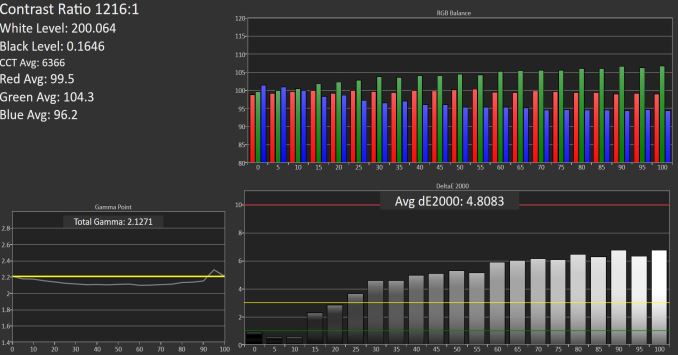
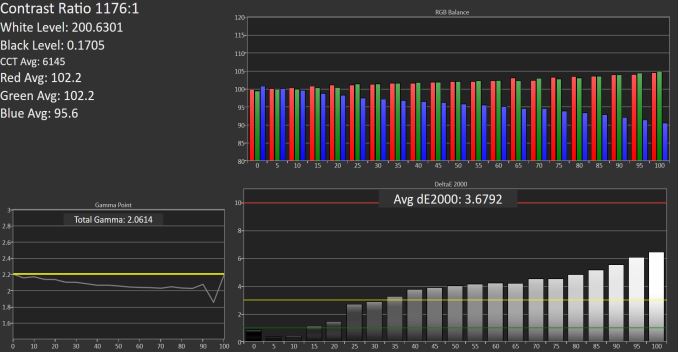
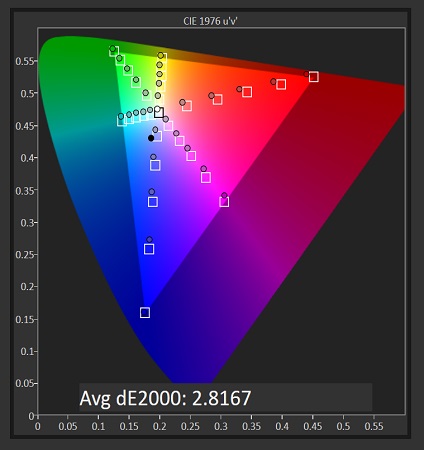
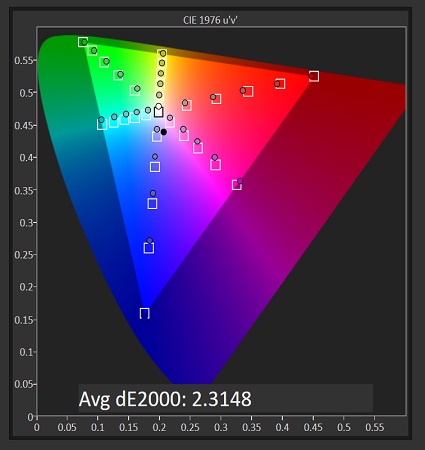
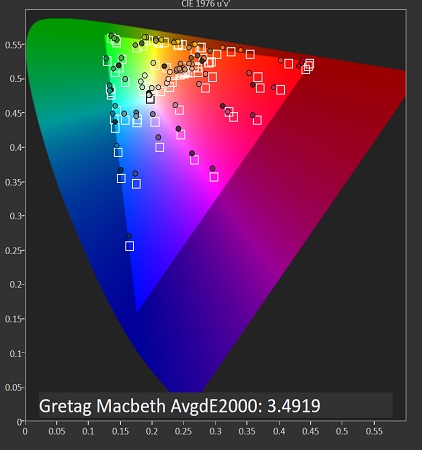
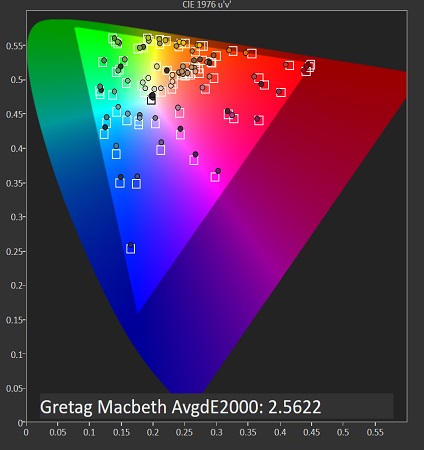












66 Comments
View All Comments
bug77 - Wednesday, March 30, 2016 - link
Hear, hear!My desktop has it's place and is the only device I game on (save for PvZ2 on my old tablet).
lmcd - Tuesday, March 29, 2016 - link
While the battery life isn't mind-blowing, I wish the storage tiers went 900-1100-1300-1500. Six hour battery life, while bad by comparison, is still more than the average person's working time away from the desk and wouldn't limit most of the people interested in this.jcbenten - Tuesday, March 29, 2016 - link
The thick bezel makes it look old. After seeing the XPS and Surface Book I could not stand to look at this screen.nagi603 - Tuesday, March 29, 2016 - link
Yeah, that bezel looks thicker than that of my old 2004 gaming laptop...Naql99 - Tuesday, March 29, 2016 - link
I bought one of these for my son. First power adapter was defective out of the box. The usb-c connector would not 'snap' into place. Returned it and the replacement unit broke in about 2 weeks when the tip fell out of the end of the cable. I assumed my son was at fault, so I purchased another for the princely sum of $140. The tip fell out of that one within 3 days. Razer refused to replacement. Well, sorry, but cannot afford to keep shelling out $140 a pop for charging bricks and they clearly have a build quality defect. Sure, the colored backlit keys are pretty, but Razer quality is sub-par and their support let me down. We ended up buying an Innergie charger for $40 that works, even though Razer support warned me that using it instead of their crappy $140 chargers would 'void my warranty'. Ok, your warranty isn't worth squat. May I recommend the dell xps precision laptops which are also eGPU capable. As for the Core, it does not even offer a thunderbolt pass-thru, so how can that be considered an actual docking unit. There will be other eGPU solutions soon. I would wait. Buyer beware. Out of the two months my kid has had it, he's only been able to use it for maybe 2 weeks.DanNeely - Tuesday, March 29, 2016 - link
It has a bunch of USB ports, an ethernet port, and a bunch of video out ports. That looks like a standard docking station to me. If I were to criticize it for anything, a lack of audio ports would be my biggest grumble.Not including TBs optional passthrough feature was probably a deliberate decision to limit competition for bandwidth the GPU needs. An x4 PCIe connection is enough that most games will run at almost full speed; only an x1 will strangle a large fraction of them. Even with just USB+ethernet you could end up oversaturating TB3: 32gb for PCIe, + 4x 5gb for USB3 + 1gb for ethernet is 53 gb vs TB3's 40gb. In practice that's unlikely to be a major concern; not least because 1 or more of the USB ports would typically be filled with low bandwidth devices (keyboard, mouse, usb headset); and USB3 devices capable of maxing the bus speed for sustained periods of time are relatively uncommon. Chaining a second high bandwidth TB device OTOH could be problematic; giving it half the total bandwidth would hurt the GPU in a significant number of games. Things that would fall under the category of "clever^H^H^H^H^H^Hstupid user tricks" like chaining a TB3 monitor and having it run off the laptops IGP (either due to misconfiguration, or not having video pass through support for the docs GPU due to cost or hardware limitations) could also end up burning people.
IMO with GPUs in the mix any sort of daisy chaining would need to wait for a future standard that supports at least 8x PCIe.
Naql99 - Tuesday, March 29, 2016 - link
I see your point, but I have a significant number of thunderbolt devices. I need to be able to hook up my external disks. In general, it is frustrating that there are so many thunderbolt devices that insist on being the the last device in the chain. In any case, I would have purchased the Core, if not for the support/wuality issues noted above.jsntech - Tuesday, March 29, 2016 - link
Razer has made enough missteps for me (Synapse 2.0, numerous failed devices which were very gently used) that despite the decent form factor competing pretty nicely with rMBP 13 and such, I won't even consider it (not to mention 16:9 is *especially* poorly suited on a 12.5" display).jsntech - Tuesday, March 29, 2016 - link
Er, the MB is probably a better comparison.TheinsanegamerN - Tuesday, March 29, 2016 - link
For that price, I would have expected for them to use the i7 6560u with the iris 540 gpu, and have better battery life. This thing is just a normal uber expensive ultrabook without the dock, at least with iris it could stand on its own a bit.